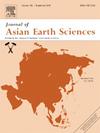A model for the Semail ophiolite thrust duplex and a late out-of-sequence thrust, northern Oman/UAE Mountains
IF 2.7
3区 地球科学
Q2 GEOSCIENCES, MULTIDISCIPLINARY
引用次数: 0
Abstract
The Cenomanian Semail ophiolite was obducted onto the Mesozoic shelf and into the foreland basin mostly as a single thrust sheet along the serpentinized Semail thrust, except for a ca. 65 km long thrust duplex. At least six, ca. 5 km thick, foreland-facing thrust sheets were thrust from east to west along intensely serpentinized mantle-crust transition zone rocks. The late out-of-sequence Fizh and Hilti Block thrust sheets concealed the hinterland. Nevertheless, the conditions that formed the duplex can be postulated. A fault system, like the one mapped in this study, cut the Hawasina and Haybi Complexes and overlying ophiolite duplex during obduction, forming fault scarps that interrupted obduction of the ophiolite and triggered deformation and uplift in the hinterland. When the taper angle of the wedge became supercritical, breakback thrusting created the first thrust sheet. Repetition of thrusting is explained by a continuous increase in the width of the wedge as the height was reduced by erosion and, possibly removal of ca. 5 km of crustal rocks during each deformation-erosion/thrusting cycle. The cycles continued until the wedge’s width was too great for uplift to raise the taper angle to a supercritical value. A deeper décollement then formed in the upper Hawasina and lower Haybi, creating the late out-of-sequence Hawasina-Haybi thrust sheet emplaced over the eroded(?) thrust duplex. Serpentinization played a key role in thrusting of the ophiolite and in the formation of the duplex and may be a prerequisite for thrusting of ophiolites.
求助全文
约1分钟内获得全文
求助全文
来源期刊

Journal of Asian Earth Sciences
地学-地球科学综合
CiteScore
5.90
自引率
10.00%
发文量
324
审稿时长
71 days
期刊介绍:
Journal of Asian Earth Sciences has an open access mirror journal Journal of Asian Earth Sciences: X, sharing the same aims and scope, editorial team, submission system and rigorous peer review.
The Journal of Asian Earth Sciences is an international interdisciplinary journal devoted to all aspects of research related to the solid Earth Sciences of Asia. The Journal publishes high quality, peer-reviewed scientific papers on the regional geology, tectonics, geochemistry and geophysics of Asia. It will be devoted primarily to research papers but short communications relating to new developments of broad interest, reviews and book reviews will also be included. Papers must have international appeal and should present work of more than local significance.
The scope includes deep processes of the Asian continent and its adjacent oceans; seismology and earthquakes; orogeny, magmatism, metamorphism and volcanism; growth, deformation and destruction of the Asian crust; crust-mantle interaction; evolution of life (early life, biostratigraphy, biogeography and mass-extinction); fluids, fluxes and reservoirs of mineral and energy resources; surface processes (weathering, erosion, transport and deposition of sediments) and resulting geomorphology; and the response of the Earth to global climate change as viewed within the Asian continent and surrounding oceans.
 求助内容:
求助内容: 应助结果提醒方式:
应助结果提醒方式:


